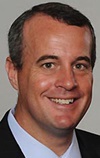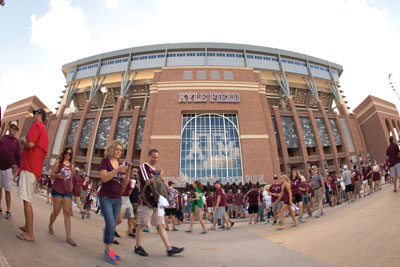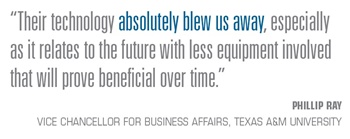IBM, the granddaddy of technology, is making a greater push into sports facility development after signing high-profile stadium deals with the Atlanta Falcons and Texas A&M University.
In both cases, 104-year-old, Armonk, N.Y.-based IBM will play a big role in providing technology solutions, especially in Atlanta. The Falcons hired IBM to help plan IT networks at the $1.5 billion stadium they are building that won’t open until 2017.
 |
At the stadium now being built in Atlanta, IBM is consulting for the Falcons on hardware services and will develop data analytics.
Photo by: COURTESY OF AMB SPORTS AND ENTERTAINMENT GROUP
|
In College Station, IBM came on board in May 2014 to help improve connectivity as part of the $485 million renovation of Kyle Field. The three-year project, to be completed this fall, stands as the most expensive to date in college athletics. In addition, the company hired sports industry veteran Jim Rushton in April as the global leader and partner for the sports, entertainment and live events practice at IBM Interactive Experience.
The moves are just the start of what IBM officials hope to be many more deals in the sports technology space. The Minnesota Vikings have had preliminary discussions with IBM regarding technology assistance at the team’s facility under construction but no deals have been signed, team spokesman Jeff Anderson said. Meanwhile, Notre Dame, planning a $400 million stadium renovation; some of Texas A&M’s fellow members of the Southeastern Conference; and officials from NRG Stadium, home of the Houston Texans, have visited Kyle Field to find out more about IBM’s work, A&M officials said.
IBM began to compete in sports technology after seeing companies such as systems integrators Siemens and Johnson Controls, plus Cisco, Extreme Networks and Mobilitie become major players in the space.
The new strategy falls in line with IBM’s shift toward developing software systems with a heavy focus on data analytics as well as filling the role as a consultant for multiple technologies.
“IBM is not a hardware company anymore,” said Todd Christner, director of Optical Network Evolution development for Corning, IBM’s partner for developing distributed antenna systems for both Kyle Field and the Falcons stadium.
In addition to partnering with Corning on the distributed antenna networks for both facilities, IBM is consulting for the Falcons on hardware services that fall outside its level of expertise, such as wireless infrastructure.
IBM is also working with the Falcons to develop mobile applications for the NFL team, the future MLS club owned by Falcons owner Arthur Blank and the stadium itself. A third piece, data analytics, is another service IBM will develop for the Falcons.
“We’re engaging with IBM for fan experience initiatives beyond the stadium infrastructure,” said Jared Miller, the Falcons’ chief technology officer. “What I believe is unique in IBM is that they can not only bring expertise on systems integration and building a proper network, but how can they take advantage of that knowledge of what they’re working with us on there to bring forward the best possible fan experience.”
The IBM/Corning deal with the Falcons was announced in December and came about after team officials saw what the tech partners had done at Kyle Field, Miller said.
Separately, IBM came on as a team sponsor, said Greg Beadles, the Falcons’ executive vice president, chief administrative and financial officer.
On its own, IBM has been involved with sports properties for years, mostly tied to sponsorships that include developing mobile applications for the Masters and Wimbledon.
Starting in 2012, IBM expanded its presence in sports beyond sponsorship by signing a deal with the Miami Dolphins to design a technology platform to more effectively manage traffic flow, monitor weather patterns and analyze fan spending on concessions and merchandise.
 |
| RUSHTON |
Rushton, the Dolphins’ former chief revenue officer, was involved in that deal, and three years later, Rushton now works for IBM after spending a year as a sales consultant for the San Diego Padres. Rushton has been busy making presentations to potential clients from a list of about 30 projects.
IBM Interactive Experience is the same group that develops the mobile apps in golf and tennis as it looks at the fan experience through the eyes of a brand strategist as well as technology. It sits outside the company’s sports marking division overseen by Noah Syken, IBM’s vice president of global sponsorships.
“It’s a fairly new space for IBM,” Rushton said. “They’ve developed a tremendous amount of experience around it, but [told me], ‘We have not yet unlocked our path to the teams and the venues.’ It’s one thing to have an immersive customer experience in the Masters app; it’s another thing to impact business for team ownership and C-level executives. One of the things we’re trying to solve is a lot of teams and venues add technology in piecemeal fashion without a master plan, unless it’s a new building. We want to be the end-to-end solutions provider for running the business 52 weeks a year.”
At Texas A&M, school officials selected the IBM/Corning distributed antenna system after first meeting with the group a little over a year ago as they went through the process for upgrading the stadium’s wireless infrastructure. Aggie fans’ inability to make cell calls at Kyle Field was a top complaint regarding the game-day experience. Texas A&M Chancellor John Sharp set a mandate for project officials to find the best technology to resolve the issue, according to Phillip Ray, the school’s vice chancellor for business affairs.
“Their technology absolutely blew us away, especially as it relates to the future with less equipment involved that will prove beneficial over time,” Ray said.
The new fiber-optic system is designed to accommodate 100,000 simultaneous cellphone connections inside the 102,500-seat stadium. It’s a major upgrade over copper-based systems and meets the higher bandwidth required to run the new 4K televisions on the market, the next step in high-definition technology, said Corning executive Christner, a former IBM employee. Fiber runs 50 percent to 60 percent cheaper per linear foot than copper, saving Texas A&M several million dollars with a single platform providing multiple stadium services.
 |
Other schools have trooped to Texas A&M’s Kyle Field to see the work that IBM is doing there.
Photo by: TEXAS A&M UNIVERSITY
|
At Kyle Field, the upfront savings make it more affordable for the cell carriers to pay fees to the school to join the network and provide cell coverage for their customers. Those fees will generate a minimum of six figures annually for Texas A&M, which owns the distributed antenna system, Ray said. AT&T, which installed the old system with Cisco, was the first carrier to sign up for the new network. Verizon, Sprint and T-Mobile are expected to follow suit although those deals are not signed, Ray said.
In Atlanta, the same IBM/Corning system will be in place at the Falcons’ stadium, where IBM is also overseeing the selection, design and installation of several technologies, plus support after the facility opens, Miller said.
For the Falcons, IBM provides guidance for choosing the right vendors to provide tech services such as Wi-Fi, physical security and Internet protocol television. Those decisions are critical for planning 10 years beyond 2017’s technology.
“One of the most important values for us is future flexibility,” Miller said. “I’m not going to be able to future-proof something. Anyone that says they can is going to be shortlived in their role. But we can build something as flexible as possible and give us a platform to grow as time goes on.”
As part of preparing for the future, IBM and Corning developed a laboratory in the basement of Kyle Field to test technologies among vendors competing for tech services. They are doing the same thing in downtown Atlanta at a site to be determined, Miller said.
The Falcons, including Miller, visited Texas A&M on a few occasions and the lab concept helped drive the team’s decision to bring IBM to the table for making technology decisions, he said.
“The challenges are not in comparing products on paper and then issuing purchase orders, but in integration,” Miller said. “How do you get these systems talking together and actually integrated on the same network? That’s what his lab will give us the opportunity to do.”







